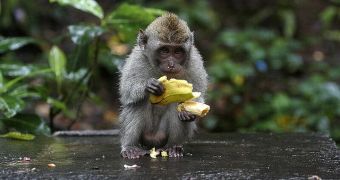If you've thought that monkeys can only live on their favorite yellow fruits and have always pictured this kind of animal with a banana nearby, well, this thing is about to change after nutritionists discovered that bananas are actually bad for the mammals and they should be replaced with vegetables.
Monkeys from Paignton Zoo in Devon will be truly disappointed by their new diet that openly bans bananas and focuses on green, leafy vegetables. According to nutritionists, monkeys eating the fruit is the equivalent of people eating cake and chocolate.
But not all types of bananas seem to be the problem, but just those ones that are cultivated by humans, as they hold big quantities of sugar and less protein and fiber. They are not only unhealthy for monkeys but also for people, as the substances used by people to cultivate bananas modify their nutritious composition.
“Giving this fruit to animals is equivalent to giving them cake and chocolate. It can also cause gastrointestinal problems as their stomachs are mostly adapted to eating fibrous food with very low digestibility,” Dr. Plowman says, according to Daily Mail.
In order to substitute the fruit, nutritionists from Paignton Zoo came up with a healthy diet based on vegetables and especially the leafy green one that help the animals stay in their best shape. Despite common opinion that monkeys cannot resist without their favorite food, caretakers admit that switching their diet wasn't too hard.
They started by slowly reducing the amounts of fruit and replacing it with vegetables high in protein, fibre and lots of vitamins and minerals. For those monkeys who weren't really keen on trying the special menu, zookeepers placed the vegetables in banana pieces and managed to trick them into eating it.
The fruit-free diet for the monkeys in Paignton Zoo already had some great results, improving the physical health of the animals and positively influencing their behavior. But the most visible result was related to their fur of the Sulawesi crested black macaques, as it became thicker and with visible color differences.

 14 DAY TRIAL //
14 DAY TRIAL //